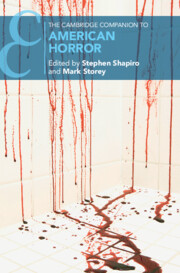Book contents
- The Cambridge Companion to American Horror
- The Cambridge Companion to American Horror
- Copyright page
- Contents
- Acknowledgments
- Contributors
- Introduction
- Part I Histories
- Part II Genres
- 7 Body Horror
- 8 Queer Horror
- 9 Folk Horror
- 10 Occult Horror
- 11 SF and the Weird
- 12 Monsters and Monstrosity
- Index
- Cambridge Companions To …
- References
12 - Monsters and Monstrosity
from Part II - Genres
Published online by Cambridge University Press: 21 July 2022
- The Cambridge Companion to American Horror
- The Cambridge Companion to American Horror
- Copyright page
- Contents
- Acknowledgments
- Contributors
- Introduction
- Part I Histories
- Part II Genres
- 7 Body Horror
- 8 Queer Horror
- 9 Folk Horror
- 10 Occult Horror
- 11 SF and the Weird
- 12 Monsters and Monstrosity
- Index
- Cambridge Companions To …
- References
Summary
This chapter maps out the central paradigms for conceptualizing the monsters of American horror, marking their inextricability from politics and moving toward identifying the principal forms of monstrosity in the early twenty-first century. Monstrosity has been defined as impure and abject, existing on borders, not categorizable; the incarnation of “otherness,” typically racial, gendered, sexual, or class; and a terrifying reflection of the “self,” as the monster has increasingly become an avatar of “normality” rather than what threatens it, embodying dominant rather than marginalized social structures and ideologies. Most recently, monsters are being generated by scientific explorations that insist on the thoroughgoing entanglement of life, the ways in which the “human” is not singular, not exceptional, but rather symbiotically entwined with nonhuman life. This form of horror is adeptly exploited in Silvia Moreno-Garcia’s 2020 novel Mexican Gothic, about an entangled fungus and a colonial family.
- Type
- Chapter
- Information
- The Cambridge Companion to American Horror , pp. 183 - 198Publisher: Cambridge University PressPrint publication year: 2022
References
Works Cited
- 1
- Cited by

